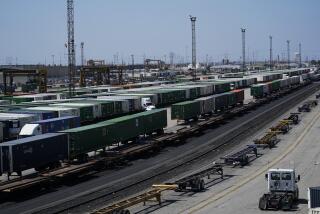NTSB Calls for Better Control Over Traffic in Southland Skies
- Share via
WASHINGTON — The National Transportation Safety Board, responding to several incidents of airplanes flying too close to one another in Southern California, Tuesday called for improvements in air traffic control operations in the area, including consolidation of radar-tracking facilities and stepped-up training of controllers.
After a four-hour meeting, the agency adopted a staff report calling for a “high priority” on a plan to provide a new facility to consolidate the Los Angeles, Coast, Burbank and Ontario terminal radar approach control stations, which guide planes when they are outside major airport control zones.
The recommendations were made to the Federal Aviation Administration, which has 90 days to respond. FAA officials in California and Washington declined to comment on the proposals until they have had a chance to study them.
Incident Over Westminster
The board’s action was linked specifically to a Feb. 13 incident over Westminster, in which a British Airways jetliner and an American Airlines plane flew within 1 1/2 miles and 200 vertical feet of each other.
But in considering its recommendations, the board broadened its concerns to eight other such incidents and to the overriding problem of crowded skies and overburdened controllers in Southern California.
As a general rule, most of the board’s recommendations are either accepted or the FAA “makes a counterproposal that we feel can do a better job,” said an FAA official. However, budgetary constraints can bear on the response and the extensive improvements proposed by the NTSB Tuesday would be costly.
In its recommendations, the safety board focused heavily on the Coast Terminal Radar Approach Control Facility at El Toro.
The facility, which was guiding the American Airlines plane involved in the February incident, should be expanded and renovated, the recommendations said, “to accommodate the increased number of radar positions” needed to provide expanded traffic control coverage in Southern California.
Some projects involving the facility should be delayed until staff shortages can be corrected, the recommendations said, “and until the facility has been expanded or relocated to accommodate” the increased number of radar positions.
Federal officials said that the installation is authorized for 66 “full performance” air traffic controllers but only 24 were on the job as of January, along with 27 trainee controllers.
“It’s an overworked facility,” said one federal official, adding that “it’s tough to attract people to work there.”
The board suggested a study on the possibility of hiring “aviation-oriented persons from the local area,” such as retired pilots and military personnel, to fill some support slots and help relieve the severe manpower shortages at the El Toro facility.
Also, the panel urged that officials “expedite the identification, selection, release and transfer” of air traffic controllers from other locations to help relieve the shortage.
Addressing the general air traffic problems in the region, the board suggested a sweeping review of the entire control system and the facilities that oversee flights in the high-density area.
“The review should focus on the adequacy of regional airspace plans,” the recommendation said, “control facilities, equipment and technology, airways and airspace design, controller staffing and training and operational procedures.”
In the February incident, 9,000 feet over Westminster, the British Airways 747 and the American Airlines BAe-146b broke FAA rules requiring a minimum separation of three miles horizontally and 1,000 feet vertically.
The incident occurred about 7 p.m., shortly after runway lights at John Wayne Airport had gone out because of a short circuit, closing the airport for about four hours.
The American Airlines flight from San Jose was being diverted to Ontario International Airport, while the British Airways jetliner from Los Angeles to London was in contact with Los Angeles controllers.
After a Los Angeles controller warned the British plane that the two craft were too close, the pilot made a quick turn to avoid danger.
While neither pilot filed a near-collision report on the incident, numerous near collisions have been reported in the region. During 1987, the FAA received 27 pilot reports of such incidents in Orange County, compared to 11 in 1985 and 16 in 1986.
More to Read
Inside the business of entertainment
The Wide Shot brings you news, analysis and insights on everything from streaming wars to production — and what it all means for the future.
You may occasionally receive promotional content from the Los Angeles Times.










